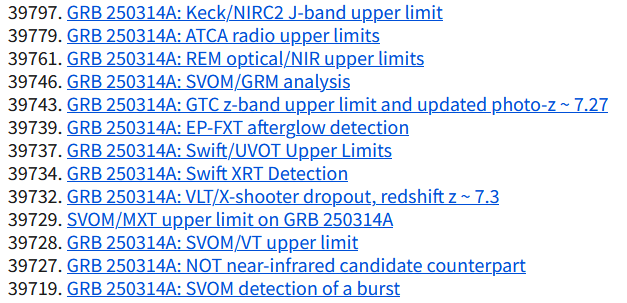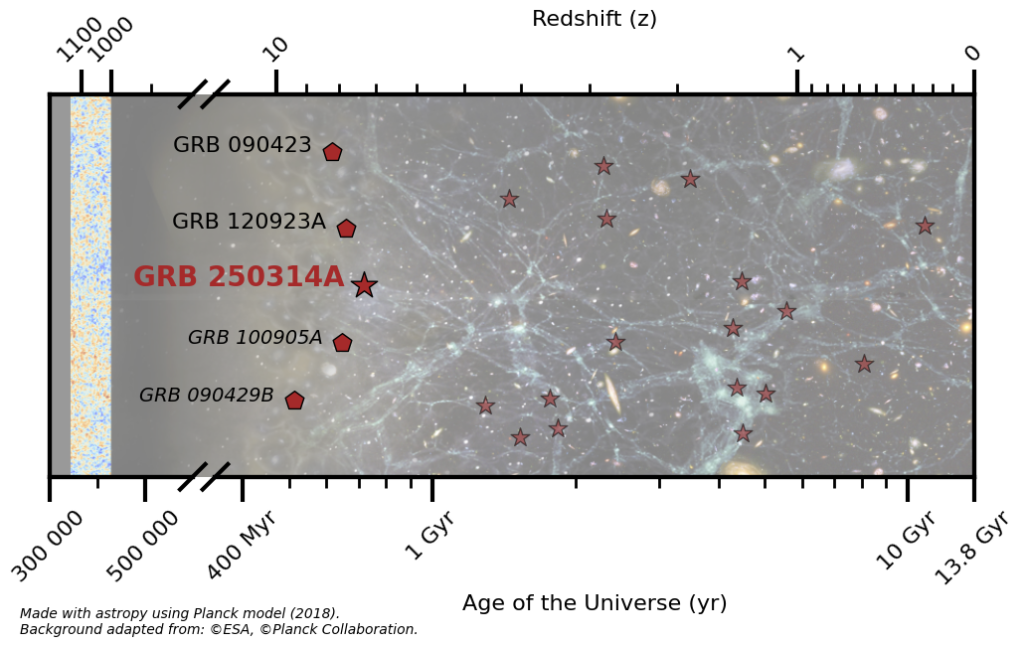GRB 250314A : A message from the depths of time
Just imagine. Around 13 billion years ago, one of the first stars in the Universe collapses into a black hole, releasing a flash of light of unprecedented power. This light travelled through the expanding Universe, past the first galaxies, then drifted through the ages… all the way to us. And on 14 March 2025, SVOM captured it.
A race against time
At 12:56pm UTC, a signal emerges from the depths of the Universe. ECLAIRs, SVOM’s watchful eye, detected it immediately and gave the alert. The machine is in motion: the satellite slews, points its small-field instruments MXT and VT, and begins to observe what could be one of the most distant gamma-ray bursts ever detected.
Thanks to the data transmitted in real time via the SVOM VHF network, our team of scientists on call are trying to determine whether this is a genuine alert or just a fluctuation in the background noise. The task is proving difficult for several reasons:
- At the time of the alert, the satellite was flying over a zone without coverage in the VHF network in the Pacific Ocean, preventing full reception of the data.
- The signal received by ECLAIRs was weak and below the detection threshold required to trigger an automatic alert to the international community.
At 1.07pm, we were truly alerted. Despite these difficulties, the simultaneous detection of the signal by the GRM instrument strengthened the scientists’ confidence. At 1.23pm, we decided to inform the international community by sending a brief message to observatories around the world.

A journey into the youth of our Universe
Thanks to the quick response of the SVOM scientists, other observatories quickly mobilised to search for the optical and near-infrared counterpart of the gamma-ray burst. The Nordic Optical Telescope, as well as the Neil Gehrels Swift Observatory and the Einstein Probe satellite, pointed their instruments at the source and pinpointed its location. Einstein Probe’s observations even confirm the transient nature of the optical counterpart, a key clue in favour of a gamma-ray burst. On the SVOM side, however, the MXT and VT instruments did not detect the counterpart. This could indicate that the event is particularly distant…
Excitement rises when, on the ground, the Very Large Telescope (VLT) and its X-shooter spectrograph take us back to the youth of the Universe. Around 17 hours after the SVOM alert, the spectrum acquired by the VLT revealed a spectral shift estimated at z ~7.3. The measurement was then confirmed by the Gran Telescopio Canarias.

Such a spectral shift means that the light from this gamma-ray burst was emitted when the Universe was only 730 million years old, compared with 13.7 billion years old today. This gamma-ray burst could well be a sign that one of the very first stars in the Universe has evolved into a black hole. It is the fifth most distant gamma-ray burst ever detected! As with the GRB 090423 and GRB 120923A bursts, the redshift of our 14 March burst was determined from its spectrum. For GRB 090429B and GRB 100905A, on the other hand, it was estimated without spectral measurement, by comparing the intensity through different filters. This method, which determines a photometric redshift, is less accurate than the spectroscopic method. Taking this into account, our gamma-ray burst is even the third most distant whose distance has been accurately measured using its spectrum.

Analyses of the data collected by SVOM and its partners will make it possible to establish the physical properties of this primordial burst and its local environment, in order to compare them with the populations of bursts detected throughout the different ages of the Universe.




